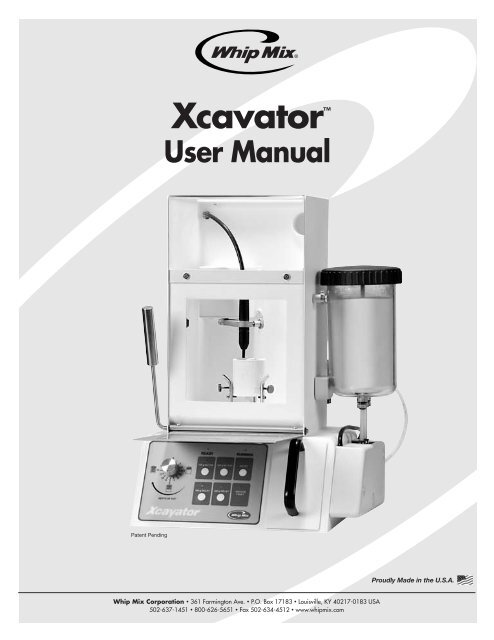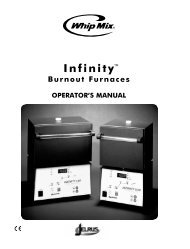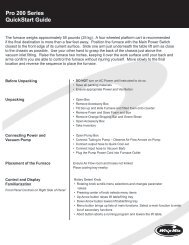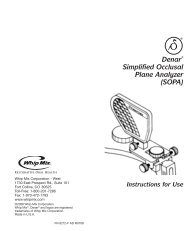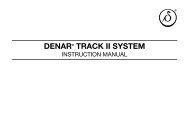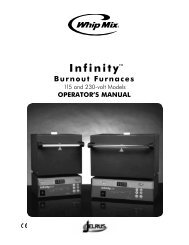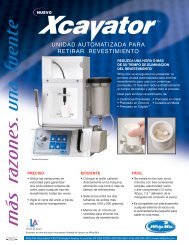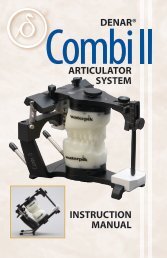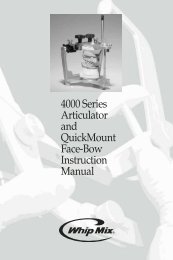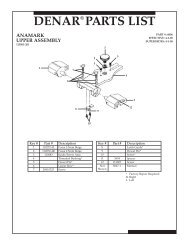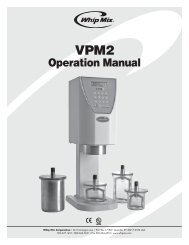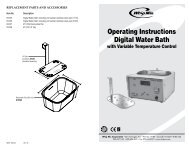Create successful ePaper yourself
Turn your PDF publications into a flip-book with our unique Google optimized e-Paper software.
<strong>Xcavator</strong>User <strong>Manual</strong>Patent PendingProudly Made in the U.S.A.<strong>Whip</strong> <strong>Mix</strong> Corporation • 361 Farmington Ave. • P.O. Box 17183 • Louisville, KY 40217-0183 USA502-637-1451 • 800-626-5651 • Fax 502-634-4512 • www.whipmix.com
<strong>Xcavator</strong> Operating <strong>Instruction</strong>sIntended PurposeThe <strong>Whip</strong> <strong>Mix</strong> <strong>Xcavator</strong> is designed to automatically remove95% of the volume of investment mold material surroundingpressed ceramic restorations where manual divestment wouldtypically be done. When used as directed, the unit willsignificantly shorten the total process time required to go frompress oven removal to pattern retrieval. The unit can be rununattended and will alert the operator when an investment moldis divested to allow efficient processing and labor usage.The unit employs state of the art robotic precision toensure consistent material removal time after time.The <strong>Xcavator</strong> is easy to operate, ergonomically friendlyand compact enough to earn its place on a work surfacein the casting room.Important Topics for Safe, Reliable OperationGroundingThe high velocity flow of glass beads across plastic ormetal surfaces will charge the beads and the surfaces theyflow over. Great pains have been taken to ground everycomponent in the <strong>Xcavator</strong> to insure equalization of staticelectrical charges. The power cord and the outlet the unitis plugged into must have 3 prongs to insure the presenceof the earth ground which is vital to the prevention of staticelectrical charge buildup. If, for any reason, you receive astatic electrical shock from any part of the equipment, youshould verify the integrity of the grounded outlet the unit isplugged into, or call an electrician. Operating the unitungrounded can result in painful shocks to the operatorand damage to the electronics of the unit itself.Never cut the ground stud off the power cord or plugthe unit into a 2 lead extension cord or outlet.Dry Air SupplyAll compressed air condenses moisture in the air lines asa result of the physics of gas compression. This moisturecan accumulate in low areas of the air piping even if thereis a master air dryer at the compressor.It is recommended that a cartridge type dryer be placedjust before the air regulator of the unit. If moist air entersthe unit it will collect in the reservoir and cause clumpingof beads and disrupt the critical air/bead ratio neededfor consistent divestment. It can also plug up either thereservoir output orifice or the bead/air injector insidethe injector block and cause inconsistent divestment.Dry Bead SupplyThe strainer supplied with the <strong>Xcavator</strong> serves two purposes;(1) it eliminates clumped beads and foreign debris whichcould clog the bead transport system, (2) it validates/invalidates the dryness of the beads. If the beads will notpass through the strainer without tapping or shaking thestrainer, then they are too moist to be transported reliably.An electric Bead Dryer Belt is supplied with the <strong>Xcavator</strong>.When placed around the bead storage container it will raisethe temperature of the beads and drive off any moisture thebeads might accumulate.Treat Pressurized Components With CareNever strike the bead jar or pull on the connecting airtubing while the system is pressurized. This can result incracking the plastic jar or wind up spraying glass beads orplastic debris around the area and pose a safety hazard.Particulate ExposureNever open the cabinet door while a divestment cycle isin progress. The exhaust system will pull the dust cloudtowards the rear of the cabinet, but air conditioning/heatingconvection currents in the room could cause a portionof the dust cloud to escape into the room and pose apossible health risk.Handling of Hot Investment MoldsAlways use laboratory tongs to handle hot investment moldsand cautiously test the temperature of divested molds beforeyou attempt to remove divested molds from the cabinet.Exhaust Flow VolumeThe built-in vacuum sensor will prohibit divesting unlessthe vacuum flow is sufficient to remove the airborne dustrapidly. If you are having dust cloud removal issues checkyour vacuum unit or central vacuum flow to ensure removalof the fine dust.Divesting Media Compositionand Particle SizesUse only 50 –100 micron glass beads with the <strong>Xcavator</strong>for the following reasons:1. Other material types may be harder than glassbeads and damage the porcelain work product.2. Other material sizes may alter the depth of cut,and/or the cut channel width.Important NOTE: The <strong>Xcavator</strong> product has beenexhaustively tested with <strong>Whip</strong> <strong>Mix</strong> brand 50 Micron glassbead media. For best and most reliable divesting resultswe strongly recommend you use <strong>Whip</strong> <strong>Mix</strong> brand beads.<strong>Whip</strong> <strong>Mix</strong> beads flow more reliably, and are less proneto clumping during high humidity conditions.THE USE OF ALUMINUM OXIDE (ALOX), BEADS IS NOT RECOMMENDEDFOR USE WITH THE XCAVATOR. ALOX BEADS WILL POTENTIALLYCAUSE DAMAGE TO YOUR PORCELAIN BECAUSE THEY ARE HARDERTHAN THE PORCELAIN. ALOX WILL ALSO CAUSE PREMATUREWEARING OUT OF THE QUARTZ NOZZLE.2
<strong>Xcavator</strong> Operating <strong>Instruction</strong>sFamiliarizationControl PanelAccess Door812 3 67451. Ready indicator2. 100 Gram cycle start key (cool mold)3. 200 Gram cycle start key (cool mold)4. 100 Gram time delay before start indicator (hot mold)5. 200 Gram time delay before start indicator (hot mold)6. Abort cycle key7. Exhaust flow Indicator8. Depth of cut selector switchSetupAir Supply1. Connect your compressed air supply to the air regulatorinlet hole shown in the photograph (Figures 1A and 1B).The inlet hole is a standard 1/8" National Pipe Thread (NPT).Air RegulatorSetpoint Adjust2. With air supply connected, pull knob upward, androtate it until gauge needle points to 35 psi (Figure 2).Note: This may need to be re-adjusted slightlyonce bead flow is established.Figure 1AFigure 1BPush knob back downward after pressure is set.Daily Moisture Bowl Check3. Pressing upwards on the black plastic ring at the bottomof the air regulator opens up a check valve and allowsaccumulated moisture to drain from the clear plasticaccumulator bowl (Figure 3). It is very important to keepdrained so that moisture does not pass through to thebead reservoir. Moist beads will adhere to each otherand prevent transfer to the nozzle.Figure 2 Figure 33
<strong>Xcavator</strong> Operating <strong>Instruction</strong>sSetup (continued)Exhaust Port4. Connect your central vacuum system or dedicated vacuumunit to the rear of the cabinet as shown (Figure 4).PowerCaution: Never operate the <strong>Xcavator</strong> unit without suctioninside the cabinet to prevent human exposure to finePARTICulate matter which can be hazardous to your health.5. Connect the furnished power cord to the unit and then toany grounded AC outlet capable of furnishing 15 amps(standard branch breaker size) (Figure 5).note: Position the unit leaving enough space around theleft hand side of the chassis so you can easily reachthe main ON/OFF switch.Figure 4 Figure 56. Place Bead Dryer Belt around the middle of the bead containerand plug into a 110V wall socket. It will warm the beads toeliminate and prevent bead clumping due to moisture/humidity.Chuck Assemblies1. There is a dedicated chuck assembly for each nominalmold size (100 & 200 gram molds) (Figure 6). The chucksare easily exchanged as work load dictates.Chuck Assembly Setup2. Before using the divester make sure the three thumbscrewsare pre‐adjusted for the type of ring-former system you use(Figure 7). If you use tapered ring-formers place a taperedinvestment mold in the chuck and adjust the thumbscrewsinward until they contact the investment. Then withdrawthem one full turn to allow enough clearance for the hotmold to slip into the chuck without interference which mightcause you to lose your grip on the ring with the tongs.100 gramFigure 6200 gramIf you use both tapered and untapered rings of each sizeyou will want to purchase additional chuck assembliesso that you don’t have to constantly re‐adjust the thumbscrews. (See spare parts list in back of manual.)Chuck Assembly Installation3. Select one of the two furnished chuck assemblies(100 gram or 200 gram) and place it over the two guidepins on the mounting plate inside the cabinet (Figure 8).Figure 7 Figure 8Checking Reservoir Gasket1. Please note the gasket in the lid of the reservoir. It is importantto keep this gasket and the mating rim of the reservoir wipedfree of beads to insure a good air pressure seal (Figure 9). Thethreads in the lid should also be wiped with a DRY cloth orbrush to remove beads accumulating in the threads.Caution: NEVER use a wet cloth as the moisture will getinto the reservoir and cause transfer problems.Figure 94
<strong>Xcavator</strong> Operating <strong>Instruction</strong>sFilling JarImportant NOTE:The <strong>Xcavator</strong> product has been exhaustively testedwith <strong>Whip</strong> <strong>Mix</strong> brand 50 Micron glass bead media. Forbest and most reliable divesting results we stronglyrecommend you use <strong>Whip</strong> <strong>Mix</strong> brand beads. <strong>Whip</strong> <strong>Mix</strong>beads flow more reliably, and are less prone toclumping during high humidity conditions.THE USE OF ALUMINUM OXIDE (ALOX), BEADS IS NOTRECOMMENDED FOR USE WITH THE XCAVATOR. ALOX BEADSWILL POTENTIALLY CAUSE DAMAGE TO YOUR PORCELAINBECAUSE THEY ARE HARDER THAN THE PORCELAIN. ALOXWILL ALSO CAUSE PREMATURE WEARING OUT OF THEQUARTZ NOZZLE.1. Remove the lid of the reservoir by rotating it by handcounter-clockwise. Place the strainer over the rim ofthe reservoir and pour the new beads into the strainerslowly, allowing time for the beads to pass through(Figure 10). Always use the strainer when filling the jar toeliminate clusters of beads, which will cause the unit tomalfunction. Enclosed with your <strong>Xcavator</strong> Unit is anelectric Bead Dryer Belt (Fig. 13). When plugged intoa 110V socket, the belt will warm the beads to preventclumping due to moisture. The belt will ensure that thebeads flow through the strainer and transport reliablyto the nozzle (Fig. 14). Fill the jar with 50 –100 micronglass beads up to the maximum fill line on the jar, thenreplace the jar lid by screwing it clockwise, then snuggingit firmly closed by hand (Figures 11 and 12).Figure 11Figure 10Figure 12IMPORTANT: Never overfill the jar as thebeads require at least a half inch ofHEAD SPACE TO allow room for aeratingthe beads so that they will transfer.CAUTION: If the lid cannot be removed by hand afterthe unit has been pressurized during a divestmentcycle, make sure the air flow noise has stopped andallow 30 seconds to allow any residual air pressureinside the jar to bleed off through the nozzle. If youcannot feel or hear any air at the nozzle andthe lid still will not respond to hand loosening,consult the troubleshooting section at therear of this manual.Figure 13Figure 14IMPORTANT NOTE:If the bead media does not flow freely throughthe strainer, this is an indication of excessivemoisture content. Moist beads will adhere toeach other and not freely separate from eachother and fall through the strainer. They willcause intermittent or even complete stoppageof transport flow to the jet nozzle. The BeadDryer Belt around the bead bucket will helpprevent this moisture accumulation.5
<strong>Xcavator</strong> Operating <strong>Instruction</strong>sTheory Of OperationThe <strong>Xcavator</strong> is designed to remove 95 percent ofinvestment material from a 100 gram or 200 graminvestment mold unattended. It will shorten theoverall press to pattern recovery time significantly.Instead of removing a hot mold from your pressing furnaceand waiting up to 50 – 60 minutes for it to cool to a safebare hand handling temperature then spending another5 –15 minutes to hand divest, you can remove the moldfrom the press furnace, press the corresponding delay cyclebutton and the <strong>Xcavator</strong> will announce when the mold is 95percent divested with a beeping sound, and the greenReady light will be lit. The divested mold will now be coolenough to remove from the <strong>Xcavator</strong> by hand, and touchupthe remaining 5 percent by hand in as little as 30 seconds.How Does it Work?The <strong>Xcavator</strong> uses a robotic grade precision stepper motorto digitally turn the investment mold in an ultra-precise rateof rotation. This rotation is computer controlled to spinslowly at the outside periphery of the mold and slowlyaccelerate as the swing arm approaches the center of themold rotation. This precision is the key to controlling thedepth of cut and the uniformity of material removalacross the horizontal material removal plane.The nozzle swing arm is also controlled by a roboticgrade precision stepper motor to digitally positionthe nozzle along each concentric cutting track withminimal overlap and high repeatability.Controlling the Depth of CutThere are four factors which affect the depth of cutin a given mold:1. Air Pressure2. Spindle Rotation Speed(as set by the Depth of Cut Knob)3. Density of Investment Material ANDConcentration of Special Liquid.4. Bead Media Size and HardnessAs a rule of thumb, the air pressure should be set to thelowest psi value that will yield satisfactory cuts throughoutthe range of investment brands and concentrations byadjusting ONLY the 16 position spindle speed selectorknob. <strong>Whip</strong> <strong>Mix</strong> has determined that 35 psig is thepressure setting which will cover the entire spectrumof currently available brands and concentrations. Thehardest and highest density investment should be run on aDepth of Cut setting towards the higher numbered positionswhile less dense investments should be run on the lowernumbered settings.An Important NoteRegarding Air PressureEven though the incoming air pressure is perhapshigher than you would normally select for manualdivestment, the direct comparison is not physicallyvalid for the following reason; when manually divestingthe nozzle is within less than a centimeter of the glasspattern. The <strong>Xcavator</strong> jet nozzle NEVER comes within2– 3 centimeters of the glass pattern and is inCONSTANT MOTION, making it impossible to dwell overany given spot on the glass pattern for more than a fewseconds. The increased distance effectively drops thepressure level of the air propelling the beads so that bythe time they reach the glass pattern the kinetic energythe beads transfer to the glass is actually less than witha manual divester.You should use only one type and size of bead media. Inpractice, the only one of these interactive factors remainingvariable should be the Depth of Cut Selector knob.6
<strong>Xcavator</strong> Operating <strong>Instruction</strong>sBefore You Commission for Every Day UseCALIBRATE EACH BRAND OF INVESTMENT OVER THE RANGE OF CONCENTRATIONS YOU ARE USING.We recommend you pour up some empty test molds for eachbrand of investment you use at the minimum and maximumliquid concentrations and burn them out, then perform testdivestments and record the spindle speed selector switchsettings to bracket the lowest concentration, least dense mold(lower numbered speed settings) and the highest density,highest concentration mold. When you are comfortable thatyou can span the entire range of mold densities, you can fillin the intervening concentration values.Again, for the maximum protection of your work product, andthe most consistent results, we recommend you keep the airpressure constant and utilize the Depth of Cut knob to alterthe spindle speed/cycle time to yield the desired depth ofcut. We recommend that you calibrate your depth of cut toland in a horizontal plane midway between the bottom ofthe central glass button, and the top of the glass buttonwhere the sprue(s) join.Typical settings for <strong>Whip</strong> <strong>Mix</strong> Formula 1 Investment:[In order from the hardest to the softest]Air Pressure – 35 psi on the regulator gauge.Bead Media - 50 micron to 100 micron pure glass beadsInvestment Type: <strong>Whip</strong> <strong>Mix</strong> Formula 1Liquid Concentration Depth of Cut Setting100% Switch Position # 590% Switch Position # 580% Switch Position # 470% Switch Position # 460% Switch Position # 350% Switch Position # 340% Switch Position # 230% Switch Position # 2Fill in the data corresponding to the Investment type you use.Note: Data must be derived from actual pressed rings as the hardness of the rings increases after the pressing heatcycle. Testing blank molds which have been through the burnout cycle, but not the pressing heat cycle will givemisleading results due to the hardening effect of the pressing heat cycle.Investment Type:Investment Type:Liquid Concentration Depth of Cut Setting @ 35 PSI Liquid Concentration Depth of Cut Setting @ 35 PSI100% Switch Position # 100% Switch Position #90% Switch Position # 90% Switch Position #80% Switch Position # 80% Switch Position #70% Switch Position # 70% Switch Position #60% Switch Position # 60% Switch Position #50% Switch Position # 50% Switch Position #40% Switch Position # 40% Switch Position #30% Switch Position # 30% Switch Position #Investment Type:Investment Type:Liquid Concentration Depth of Cut Setting @ 35 PSI Liquid Concentration Depth of Cut Setting @ 35 PSI100% Switch Position # 100% Switch Position #90% Switch Position # 90% Switch Position #80% Switch Position # 80% Switch Position #70% Switch Position # 70% Switch Position #60% Switch Position # 60% Switch Position #50% Switch Position # 50% Switch Position #40% Switch Position # 40% Switch Position #30% Switch Position # 30% Switch Position #7
<strong>Xcavator</strong> Operating <strong>Instruction</strong>sStep By Step Directions For UseStep 1Step 2Know your material brand and mixconcentration percentage.Make sure there is at least 3 inchesof bead media showing inside the reservoir toensure completion of the current mold divestment.Step 3Step 4Select the mold chuck size which correspondsto the ring size (100 gram or 200 gram) (Figure 1).Open the door on the <strong>Xcavator</strong> by swingingthe handle towards you (Figure 2).Step 5 Insert the chuck onto the mounting plate (Figure 3).100 gramFigure 1200 gramStep 6Remove the freshly pressed hot moldfrom the pressing furnace.Pick up the still hot mold with tongs and placeit on the open door of the <strong>Xcavator</strong> momentarily(with the press plunger facing up) (Figure 4) thenreverse the forceps and re‐grip the mold as closeto the door as possible and flip the mold invertedso that the press plunger is now facing downward.Step 7Place the mold on the three threaded screwsinside the chuck assembly so that the moldis centered between the three posts. Releasethe tongs and withdraw them (Figure 5).Figure 2Figure 3Step 8Close the door by swinging the handle upand away from you. The Ready/Idle LED willbe on*, signifying the unit is ready to begindivestment (Figures 6 and 7).* As long as the unit senses flowin the dust exhaust system.CAUTION: Do not defeat this safety feature, norOPERATE the unit with the door open. The dustgiven off by the airborne investment particlescan be hazardous to your health.Figure 4Figure 5Figure 6Figure 78
<strong>Xcavator</strong> Operating <strong>Instruction</strong>sStep By Step Directions For Use (continued)Step 9Position the Depth of Cut Selector knob to thepre‐determined position for the type of investmentand the concentration of the mix for the specificmold you just put in the <strong>Xcavator</strong> (Figure 8).Step 10 Press the Delay button corresponding to themold size you just put in the <strong>Xcavator</strong>. You cango about other duties until the <strong>Xcavator</strong> beepsand the Ready LED lights (Figure 9).NOTE: If the mold has cooled naturally formore than 10 minutes you can bypass the timedelay function by pressing the “Active” buttonfor the given ring mass and the divesting cyclewill start immediately.Figure 8CAUTION: DO NOT OPEN THE CABINET DOOR UNTILTHE READY LIGHT TURNS GREEN AND THE BEEPERBEEPS. OPENING THE CABINET PREMATURELY(BEFORE THE BEEPER) CAN ALLOW HAZARDOUSDUST PARTICLES TO ESCAPE INTO THE room.Step 11 Open the door and remove the 95% divested moldby hand, as it will now be cool enough to handlesafely with your bare hand (Figures 10).Step 12 Use your manual divester briefly, if necessary, toremove any material “shadowed” by the spruearms or inside the hollows of the copings.Figure 9Figure 109
<strong>Xcavator</strong> Operating <strong>Instruction</strong>sMaintenanceMaintenance ScheduleSuggested Frequency: WeeklyGeneral CleaningThe inside of the plastic shield may become staticallycharged and coat over with dust from time to time. Usea clean damp cloth or paper towel to wipe it clean.The cabinet exterior may be cleaned with a damp cloth.Jar Lid Gasket CleaningOver time, bead fragments and dust can worm their way upinto the retention groove of the Jar Lid and cause air to escapefrom the jar, which is one of the two primary reasons for lossof cutting depth (The other reason is the O-Ring displayed inthe pictorial on page 11). This simple procedure can be quicklyperformed to restore the proper cutting depth.Excess bead/investment debris inside the unit may be sweptinto the slot opening inside the cabinet using the brush providedwith the <strong>Xcavator</strong>. When the drawer below becomes full it canbe removed by pulling it towards you [support underneathwith your other hand] and fully withdraw from the cabinetfor transport to a recycling unit or disposal container.Use a DRY cloth or paper towel to clean the threads of the cap.Unscrew the Jar Lid and use a dry cloth to clean the dustand/or any beads adhering to the square Gasket in the lid asshown in the picture above. If the gasket is not seated flat inthe groove, pry it loose and remove it. Once removed, cleanall surfaces with the dry cloth and also clean the groove.Never use water or any other liquid to clean the Gasketas it will promote bead clumping. Replace the squareGasket in the groove. Screw the lid onto the jar untiltight, then remove it and inspect the Gasket positioning.If the Gasket is not sitting flat in the groove repeat theprocess until it is flat. If there are still waves or bulgesin the Gasket, replace it with a new Gasket.This plastic bowl should be checked weekly to see ifmoisture has accumulated. If it has moisture, you can drainit by grasping the black plastic ring underneath the clearbowl and pushing it upward. This will open a check valveallowing the incoming air pressure to blow the bowl empty.Note: you will hear the whooshing noise ofthe air escaping while you have the blackplastic ring raisedSimply release the black plastic ring when the bowl isempty and a spring will snap it back into place, closingthe relief valve. The whooshing noise should cease. If itdoes not, simply push up and release the ring until thenoise disappears.10
<strong>Xcavator</strong> Operating <strong>Instruction</strong>sMaintenance (continued)Nozzle Tip O-Ring Cleaning andReplacementOver time, bead fragments and dust can worm their wayaround the O-Ring and cause air to escape from the Wand,which is one of the two primary reasons for loss of cuttingdepth (The other reason is the Lid O-Ring). This simpleprocedure can be quickly performed to restore theproper cutting depth.Unscrew the Nozzle Cap (#1 in the pictorial) and removethe small O-Ring (#2 in the pictorial) . Clean any dust orgrit from the O-Ring with a dry cloth.Never use water or any other liquid to clean theO-Ring as it will promote bead clumping. The O-Ringwill have a flattened shape when removed, but willspring back into a donut shape after a couple ofminutes. This is entirely normal.Clean the Nozzle Cap interior by blowing it out or wipingwith a Q-tip or other dry material.Reassemble in the order shown in the pictorial. Tighten theNozzle Cap moderately. The O-Ring should be changedmonthly. There are 12 spare O-Rings in the accessory box;enough to last 1 year. Additional packages of 12 may bere‐ordered with item #5, part number shown at right.Nozzle ReplacementThe nozzle should give at least 6 months of service undermoderate usage (8 –10 rings / day). You can tell when thenozzle requires replacement by noticing whether the depthof cut becomes significantly shallower than when the tipwas new (provided the air pressure setting and Depth ofCut settings have not been altered).Turn the <strong>Xcavator</strong> power off. Open the front door of the<strong>Xcavator</strong> and reach in and grasp the cutting hand pieceand swing it into the center of the door opening. Unscrewthe Nozzle Cap on the lower end of the Wand by turning itclockwise. When viewed from above the Wand, the nozzleand the O-Ring should separate from the Wand and you canwithdraw these three items in your hand. (See pictorial at right.)4321Description Item #1. #5332-2 Nozzle Cap 098302. #5332-1 Nozzle Tip & O-Ring 098073. #5332-4 Wand 098314. #5332-3 Tube 098325. Pkg. 12 O-Rings 09818Note: The O-Ring goes inside the nozzle cap AFTERthe nozzle. Remove the O-Ring, then the old nozzlefrom the nozzle cap. Place the new nozzle into thenozzle cap, allowing the nozzle to drop into the holein the cap. Place the new O-Ring provided on top ofthe new nozzle.Re-attach the three pieces to the end of the Wand byscrewing the Nozzle Cap counter-clockwise whenviewed from above the Wand.11
<strong>Xcavator</strong> Operating <strong>Instruction</strong>sTroubleshootingDiagnosing Cutting IssuesTypical cutting issues result ininvestment molds which are notfully divested or are not divested atall. An example might be a singlehole at the initial starting point atthe outside of the investment moldas shown in figure 1.Another example might be askipping circular groove as shownin figure 2.If the investment mold platform isrotating during the cycle but youhave either of the two removalpatterns above then the cause is alack of bead flow to the tip of thecutting wand.Figure 1Figure 2The most likely cause for lack of continuous beadflow is an elevated moisture content in the beads. Thiscan happen in the bead storage bucket, which is why itis important to keep the Bead Dryer Belt and pluggedin to keep the beads warm enough to prevent moistureaccumulation. Make sure you plan ahead and add theBead Dryer Belt to the bucket of beads the day beforeneeded. The Bead Dryer Belt is a low wattage heaterand it will take 12–18 hours to warm the beads.The best way to judge whether the beads have taken onmoisture in the bead bucket is to observe how they flowthrough the grey plastic strainer as you refill the jar. If theystack up on top of the mesh and you have to tap on thestrainer to get them to flow through, this is an indicationof high moisture content. Dry beads will flow through thestrainer in a uniform flow within five seconds. Note: Non<strong>Whip</strong> <strong>Mix</strong> brand beads may flow through the strainer yetstill stack within the bead jar.The trick to keeping the beads dry is to make sure thestorage temperature is five degrees or so above the roomtemperature, this is the reason the Bead Dryer Belt isincluded with your <strong>Xcavator</strong> system.An indication of high moisture content once the beadsare in the jar can be seen when the unit is in operation.The beads inside the jar should “cave-in” on themselvesevery thirty seconds or so, such that the “funnel” at thetop surface of the beads has a gentle slope.should be full of beads. You can tell this by placing yourfinger behind the tubing and if the tubing is full of beads youwill not see the shadow of your finger behind the tubing.If the tubing develops air bubbles or runs completely dry(turns almost transparent) and the Bead Jar has Beads, thisis the moisture gluing the beads together at the bottom sothey won’t pass into the tubing (even with 35 psi pressingdown from the top of the Bead stack). When this happens,the best remedy is to scoop out or vacuum out the beadsand refill the jar with dry beads.Moisture in the Supply AirTypical cutting issues result in investment molds which arenot fully divested or are not divested at all. An examplemight be a single hole at the initial starting point at theoutside of the investment mold as shown in figure 1.If the beads are dry going in, but demonstrate the tendencyto accumulate moisture once inside the bead jar, then thesource of the moisture is the air supply itself.This can range from micro drops of moisture too fine to seewith the eye to a visible vapor which rapidly accumulatesinside the clear plastic catch bowl on the bottom of the airregulator. (The air regulator is located on the back of the<strong>Xcavator</strong> cabinet and has the pressure gauge on it).If the air supply is far away from the <strong>Xcavator</strong>, moisturemay collect in low spots inside the delivery lines. If moistair is a chronic problem, cartridge dryers may be obtainedfrom WW Grainger or a plumbing supply company andfitted just ahead of the air regulator to dry the air before itenters the <strong>Xcavator</strong>.Depth of CutFirst, check the obvious causes:1. Check that the Knob selection is correct for theinvestment type and special liquid concentration.2. Check incoming air pressure is 35 psi on theAir Regulator gauge.3. Verify the bead level in the jar is slowly dropping.4. Clean/replace nozzle tip.If the depth of cut is uniform (no skipping or holes as in thediagrams above) but the depth of less than normal (for yourregular knob setting) then the cause is a pressure loss inthe air system. The block diagram on page 13 shows thebead transfer system and how the incoming air powers andaccelerates the beads to the needed velocity to do the workof removing the investment:If the funnel resembles a vertical “pipe”, extending more thanone-half inch or so down into the beads, it is the elevatedmoisture content causing them to stick together like glue.Another indication is the two inch plastic tubing on thebottom of the bead jar closest to the front of the <strong>Xcavator</strong>12
<strong>Xcavator</strong> Operating <strong>Instruction</strong>sTroubleshooting (continued)Reference the diagram above as you read thedescription below.The air pressure is regulated to 35 psi in the air regulatorand turned on and off in the air valve, then passes into thebrass manifold block where part of the air goes upward intothe top of the bead jar and presses downward on the beads.The rest of the air travels to the left in the diagram andgets mixed with beads in the bead injector. The combinedbead/airstream exits the brass manifold block at the left inthe diagram and travels via the black tubing to the wandand finally out the tip where the mixture collides with the topof the investment mold, removing the investment material.The entire system, including the bead jar is pressurized to35 psi. If any leaks occur, this reduces the velocity of thebeads and hence lowers the cutting force.The two primary locations where leaks can developare in the two O-Ring seals. Beads can worm their wayunderneath the sealing surfaces, creating a path for airto escape. (See O-Ring Seal #1 in the Jar Lid and O-RingSeal #2 in the wand in the diagram above)Mold Not Cut to Center –Premature Cycle TerminationPress the Abort key to reinitialize the system, thendeliberately select a smaller ring size cycle (usually100 gram) to finish the mold in progress. The most likelycause is fluctuating or low volume flow of the vacuumsensor during the run. Replacing the dust collector bagis the best way to increase the vacuum air flow.Oblong Cutting Inside MoldThe mold is not centered inside the chuck or the wrong(too large) chuck is installed or a non‐standardring‐former was used.Jet Begins Cutting Too Far Inside The Mold1. Wrong Cycle selected (TOO SMALL)2. Internal synchronization lost –Press Abort key to re-synchronize3. Chuck assembly not seated over thetwo index pins on the mounting plateThe procedure for cleaning the O-Ring Seals is describedin detail in the Maintenance section of this manual.13
<strong>Xcavator</strong> Operating <strong>Instruction</strong>sTroubleshooting (continued)Adjusting the Wand Height forOptimum ResultsThe default wand height setting may not be optimized foryour conditions to produce the desired uniformity of the cut.If the Wand is too close to the top of the investment mold’s topsurface, you may get concentric “tree ring” patterns with thinpartitions between the “grooves”. If this is undesirable, youcan loosen the thumbscrew holding the wand to the swingarm and raise the wand approximately 1/8". This will allowfor a wider “groove” or “track” during cutting so that youdon’t have the thin partitions between “tracks”.A word of caution though, the farther away the Wandis from the top of the investment mold, the less cuttingforce at a given knob setting. You can compensate forthe reduced depth of cut by increasing the knob settingby one “click” clockwise.The maximum recommended gap between the end of thecutting tip and the top of the investment mold should notexceed 5/16" of an inch or else the outer wall of theinvestment mold will be penetrated and this willsignificantly alter the flatness of the “floor” of the resultingdivested area. (See below)Wand Too Close Leaves “Partitions”Diagnosing Non-Cutting IssuesNo Ready/Idle IndicationIf the Ready/Idle indicator is off AND one of the cycleindicators is lit, press the Abort key, which should causethe cycle indicator to first extinguish, then after a fewseconds (and the swing arm going to the rear most parkposition) the Ready/Idle indicator should light.If the Ready/Idle indicator is off AND the ExhaustFlow is off, please see “Vacuum Fault Indication” below.If the Ready/Idle indicator is off AND no other indicatorsare lit, please see “No Indicators Lit” below.Vacuum Fault IndicationIf the Vacuum indicator is lit, even when connected to arunning vacuum source, place your hand over the exhaustport inside the cabinet. You should feel moderate suction.If not, check the filter bag in your exhaust system. If youstill do not get the Exhaust Flow indication, pinch the sensortubing to see if there is any blockage in the sensor line, orremove the tubing and manually blow it clear of debriswith an air jet. Replace the tubing and press the Resetbutton. The Exhaust Flow indicator should now be lit.If not, Call Technical Support.Spindle Does Not Turn And/Or SwingArm Does Not Move But LEDs Lit1. Check Cable Connections2. Call Technical SupportNo Indicators Lit1. Make Sure Outlet Has Power2. Check Fuses3. Call Technical SupportWand Too Far Penetrates Outer WallAnd Creates a “Hump14
<strong>Xcavator</strong> Operating <strong>Instruction</strong>sSpecificationsLine Voltages:100 VAC, 60 Hz Use Fuse Type: 5 x 20 mm 2F Fuse Rating: 2.0 Amps115 –120 VAC, 60 Hz Use Fuse Type: 5 x 20 mm 2F Fuse Rating: 2.0 Amps208 – 240 VAC, 50 Hz Use Fuse Type: 5 x 20 mm 2F Fuse Rating: 2.0 AmpsDimensions:Product Weight:Shipping Weight:Investment Mold:19.25 in. (48.9cm) Height, 14.5 in. (36.9cm) Width, 15.5 in. (39.4cm) Depth29 lb (13.1 kg)36 lb (16.3 kg)100 gram; typically 1.4 inches in diameter by 2 inches tall200 gram: typically 2.2 inches in diameter by 2 inches tallDelayed Start Times: 100 g Delay = 6.25 min 200 g Delay = 9.6 minEnvironmental SpecificationsIntended for indoor use within operational parameters.Fluctuations of main power supply not to exceed +/- 10% of nominal voltage.Altitude:up to 2000 meters (6,560 ft.)Temperature: 13°C to 41°C (55°F to 105°F)Maximum relative humidity of 70% for temperatures up to 35°C (95°F)decreasing linearly to 50% relative humidity at 35°C (104°F)Pollution Degree: 1Installation Category: 2Divestment TimesSelectorPosition100 gmCycle Time200 gmCycle Time0 2.51 min. 5.51 min.1 2.64 min. 5.78 min.2 2.77 min. 6.07 min.3 2.92 min. 6.40 min.4 3.08 min. 6.76 min.5 3.27 min. 7.16 min.6 3.48 min. 7.62 min.7 3.71 min. 8.14 min.8 3.99 min. 8.74 min.9 4.30 min. 9.43 min.10 4.67 min. 10.23 min.11 5.11 min. 11.19 min.12 5.63 min. 12.35 min.13 6.28 min. 13.78 min.14 7.10 min. 15.57 min.15 8.17 min. 17.91 min.Reservoir Bead ConsumptionBead consumption will vary significantly according to:• Air pressure• Bead size• Concentration percentage of the special liquidin the investment (mold hardness)• Depth of cut (knob) settingPacking ListThe following components/itemswere shipped with your order:1. <strong>Xcavator</strong> Assembly 5. 100 Gram Chuck Assembly2. AC Power Cord 6. 200 Gram Chuck Assembly3. Strainer 7. Bead Dryer Belt4. Brush, 2-inchDescription / Item #<strong>Xcavator</strong> Automated Divesting Unit 09800Replacement Parts List#5332-1 Nozzle Tip & O-Ring 09807#5332 Pen With Tubing Assembly 09813#5331 Reservoir with Lid 09819#5356 Reservoir Gasket 09821#5303 Clear Shield 09809#5353 Strainer 09811#5354 Air Regulator & Valve Assembly 09823#5343 Encoder Switch 09825#5327A 100 Gram Chuck Assembly 09827#5330A 200 Gram Chuck Assembly 09829Glass Beads - 50 lb. 09805Bead Dryer Belt 09806Technical SupportCall 800 626-565115
MPL5300 12/11


